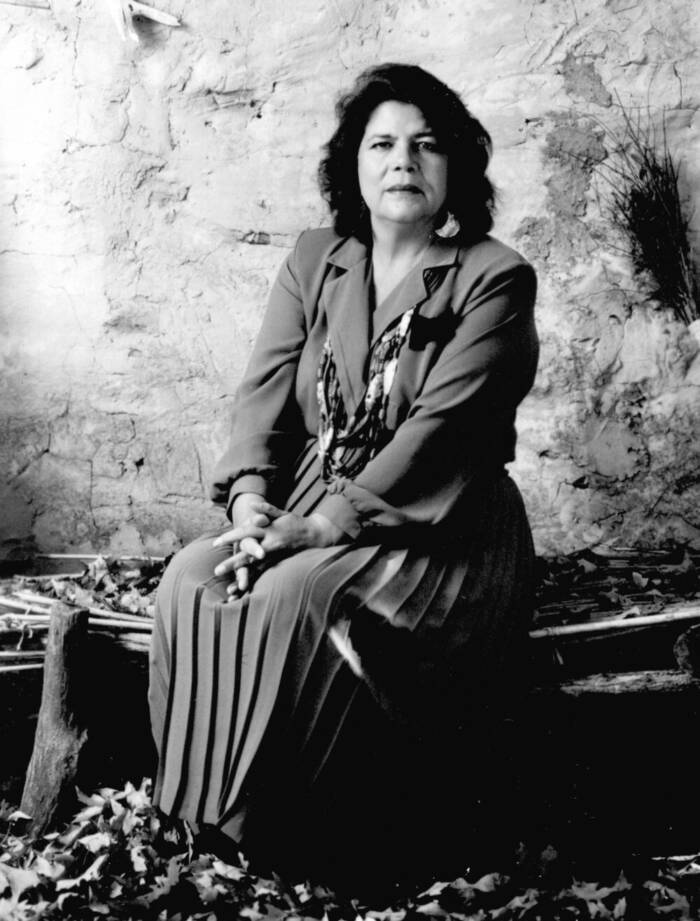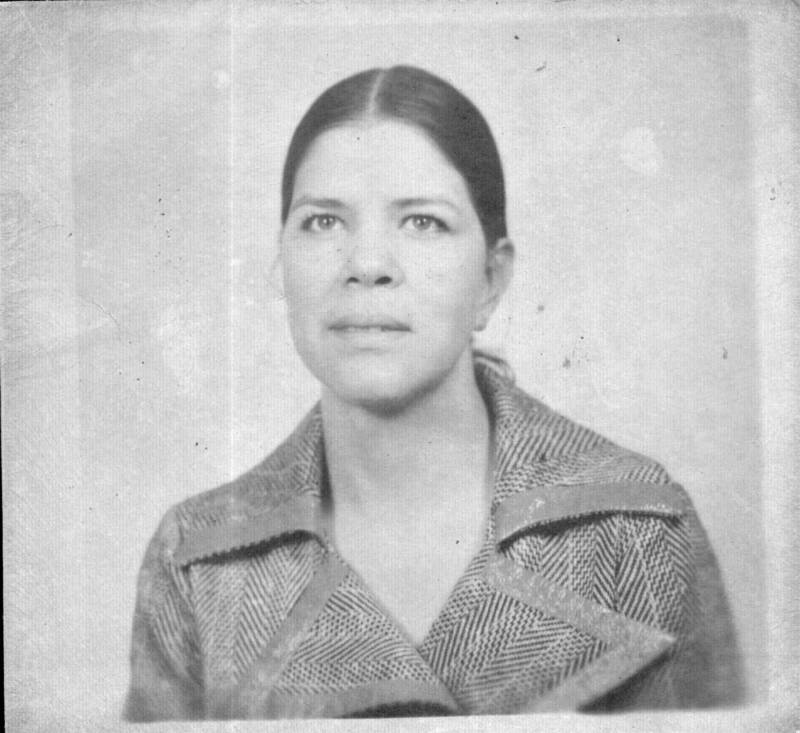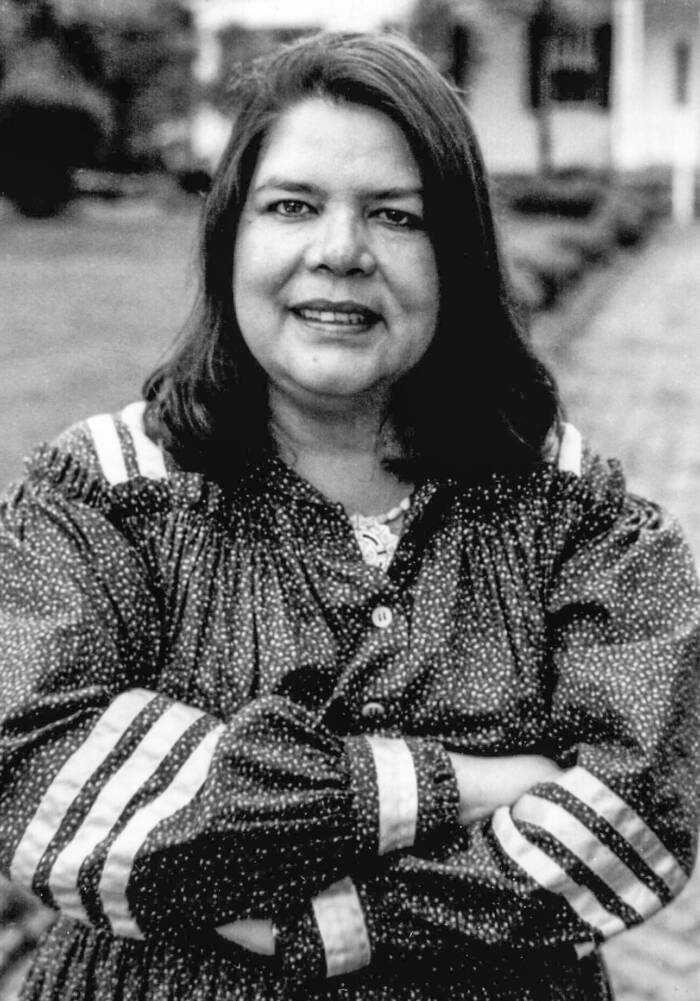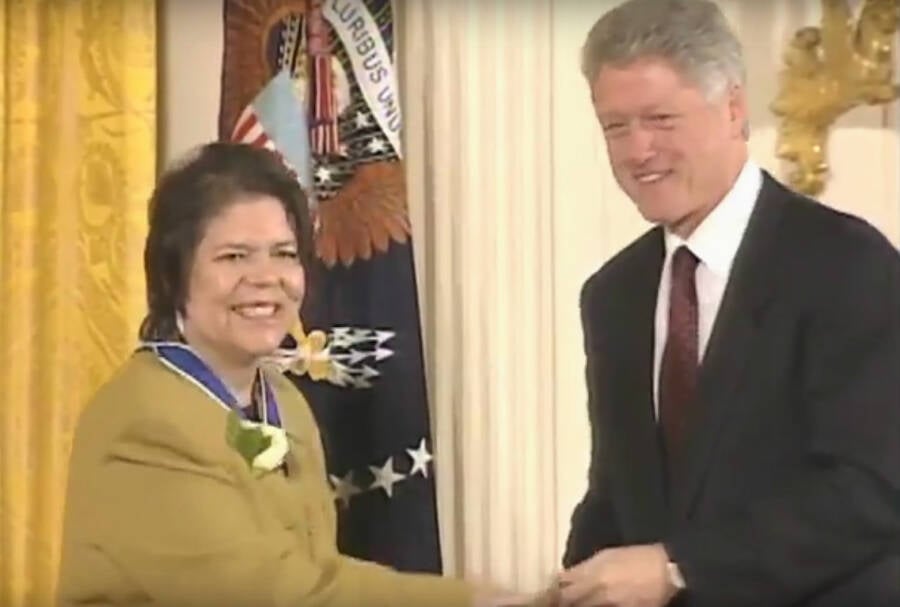Born into poverty, Wilma Mankiller overcame numerous obstacles to become the Principal Chief of the Cherokee Nation — and to improve the lives of countless Native Americans along the way.

Oklahoma Historical SocietyA 1986 photograph of Wilma Mankiller, shortly after she became Chief of the Cherokee Nation.
After growing up in poverty on Cherokee Nation land, Wilma Mankiller would go on to transform her tribe for the better. But the journey wasn’t easy.
In 1957, Mankiller’s family was relocated from their ancestral home to San Francisco. There, young Wilma witnessed an intertribal demonstration that would inspire her to launch her own career as a social activist, striving to advocate for Indigenous rights. By 1987, Mankiller had been elected chief of the Cherokee Nation, making her the first woman to be elected chief of any major Native American tribe.
“One of the things my parents taught me, and I’ll always be grateful,” Wilma Mankiller said, according to the National Women’s History Museum, “is to not ever let anybody else define me.”
This is her story.
From Oklahoma To San Francisco
Wilma Mankiller was born in Tahlequah, Oklahoma, the capital of the Cherokee Nation, in 1945. The sixth of 11 children, young Wilma would one day grow up to become chief. That seemed an unlikely outcome at the time. Not only had no woman ever been elected chief of a major Native American tribe, but Mankiller grew up in poverty, in a rural home with no electricity, no indoor plumbing, and no telephone.
When Mankiller was 10 or 11 years old, her family left their ancestral home. As part of the Indian Relocation Act of 1956, the Bureau of Indian Affairs had promised good jobs to Native Americans who left federally subsidized lands. So the Mankiller family headed west for San Francisco, where Wilma’s father would work in a warehouse.

Oklahoma Historical SocietyThe Mankiller family lived in a home with no electricity before relocating to San Francisco.
“I remember as we drove to the train, I felt so sad,” Wilma Mankiller told the New York Times in 1993. “I was trying to memorize every tree, and what the school looked like, which flowers were blooming in my grandfather’s front yard, all those sorts of things.”
Over a century earlier, Mankiller’s ancestors had walked the Trail of Tears, leaving their ancestral lands to settle in “Indian Territory.” Mankiller saw a parallel with her family’s relocation.
“I set out on what I call my own little Trail of Tears,” she said.

National Trust for Historic PreservationWilma Mankiller married and became a mother as a teenager.
In California, Mankiller married her first husband, an accountant named Hector Hugo Olaya de Bardi, at the age of 17. The pair had two daughters, and by the time she was 20, it seemed as though Mankiller had settled into the role of a housewife.
Before long, however, she became swept up in the unrest of the 1960s. And witnessing social activism would change the course of Mankiller’s life.
The Occupation Of Alcatraz
In November 1969, a group called Indians of All Tribes landed in San Francisco. The activists occupied Alcatraz Island to bring attention to Native American issues.
Wilma Mankiller joined the demonstration and was profoundly inspired by what she witnessed. At the time, it was the first intertribal protest to bring national attention to Native American rights.
“When Alcatraz occurred,” Mankiller said, “I became aware of what needed to be done to let the rest of the world know that Indians had rights, too.”

National Park ServiceDuring the 19-month occupation of Alcatraz, the group Indians of All Tribes reclaimed the then-abandoned federal land.
The demonstration lasted for 19 months. By the time the occupation ended, the Nixon administration had introduced reformed policies on Indigenous land rights.
Meanwhile, Wilma Mankiller was beginning to make changes of her own.
“I had felt there was something wrong with me because I wasn’t happy being a traditional housewife,” Mankiller told the New York Times. “I started listening to what these people were saying. What Alcatraz did for me was, it enabled me to see people who felt like I did but could articulate it much better. We can do something about the fact that treaties are no longer recognized, that there needs to be better education and health care.”
Inspired by the Alcatraz occupation and by the women’s movement, Wilma Mankiller became director of the Native American Youth Center in Oakland. And in the 1970s, she returned home to Oklahoma, where she continued her activism work.
Wilma Mankiller, The First Woman Chief Of The Cherokee Nation
When Wilma Mankiller arrived in Bell, Oklahoma, she learned that hundreds of Cherokee families had no running water. As the Cherokee Nation’s economic stimulus coordinator and founder of the Community Development Department, Mankiller got to work, leading the construction of a 16-mile waterline to serve the community.
Mankiller’s success attracted attention. Chief Ross Swimmer of the Cherokee Nation asked Mankiller to serve as his Deputy Chief in 1983. Two years later, Mankiller became Principal Chief when Swimmer took a job leading the Bureau of Indian Affairs.

Oklahoma Historical SocietyWilma Mankiller’s work in community development led to a leadership opportunity in the Cherokee Nation.
Then, in 1987, Mankiller became the first woman to be elected chief of the Cherokee Nation — or indeed, of any major Native American tribe. She won reelection in 1991. In that race, Mankiller captured 83% of the vote.
As chief, Mankiller tripled Cherokee tribal enrollment and expanded the nation’s healthcare system and housing services. Infant mortality rates dropped, employment rates doubled, and educational attainment rose. Mankiller even signed a self-government agreement between the Cherokee Nation and the federal government.
The Legacy Of Chief Wilma Mankiller
Chief Wilma Mankiller received national recognition for her leadership. Ms. magazine named her Woman of the Year in 1987. In 1993, she was inducted into the National Women’s Hall of Fame, and in 1998, President Clinton awarded her the Presidential Medal of Freedom — the nation’s highest civilian honor

Clinton Presidential LibraryPresident Bill Clinton awarded Wilma Mankiller the Presidential Medal of Freedom in 1998.
Yet Mankiller remained humble. When an American Indian art exhibit asked the chief for a pair of shoes to display, Mankiller sent a pair of her everyday walking shoes.
“Remember that I am just a woman who is living a very abundant life,” Mankiller said. “Every step I take forward is on a path paved by strong Indian women before me.”
The national attention also led to questions about Mankiller’s last name, a traditional term for a Cherokee military rank.
“Some people do earn their names in native culture,” Mankiller explained. “I didn’t, but I don’t always tell people that. Sometimes I just say that Mankiller is my name, I earned it, and I let ’em wonder.”
In 2010, Wilma Mankiller died from pancreatic cancer. She was 64 years old.
“If I am to be remembered,” Mankiller wrote in her 1993 autobiography, according to the Oklahoma Historical Society, “I want it to be because I am fortunate enough to have become my tribe’s first female chief. But I also want to be remembered for emphasizing the fact that we have Indigenous solutions to our problems.”
Wilma Mankiller changed history. Next, read about nine of the most powerful Native American warriors in history. Then, check out the story of Maria Tallchief, America’s first prima ballerina.





